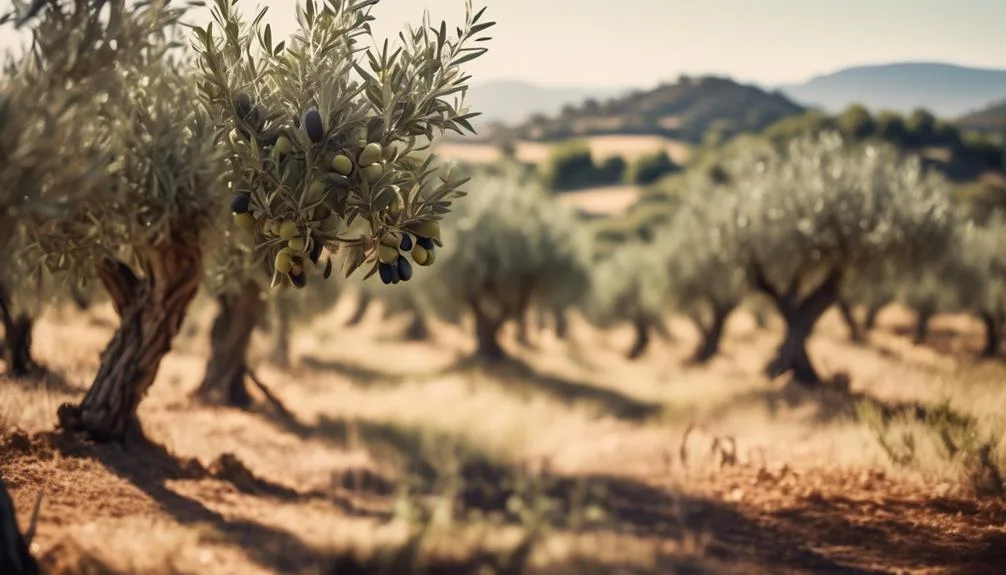Olive trees are prized for their fruit and oil, but when they spread beyond their natural habitats, they can harm local ecosystems. This is a concern in places like California and the Mediterranean region.
Why are olive trees a problem in these areas, and what are the consequences of their unchecked growth? Let's take a closer look at the regions where olive trees are causing problems and the reasons behind their invasive behavior.
Key Takeaways
- Olive trees are considered invasive in Australia, New Zealand, California, and the Mediterranean region.
- Invasive olive trees outcompete native vegetation, reducing biodiversity and altering ecosystems.
- Control measures for invasive olive trees include mechanical methods, chemical control using herbicides, and biological control through the introduction of natural enemies.
- Public awareness campaigns and strict biosecurity measures are essential to prevent further proliferation of invasive olive trees.
Australia
In Australia, olive trees have become a growing concern due to their invasive nature and impact on the native ecosystem. These trees can outcompete native vegetation, reducing biodiversity and disrupting natural habitats.
The ecological impact of olive trees includes altering soil composition, increasing fire risk, and reducing water availability for other plants.
To mitigate this issue, various control measures are being implemented. These include mechanical methods such as uprooting or cutting the trees, chemical control using herbicides, and biological control through the introduction of natural enemies like insects or pathogens.
Additionally, public awareness campaigns are being conducted to educate the community about the detrimental effects of olive trees on the environment.
California
Amidst the diverse landscapes of California, olive trees have increasingly posed a significant challenge due to their invasive characteristics and impact on the local environment.
The Mediterranean climate in California provides favorable conditions for olive trees to thrive, but their aggressive growth and ability to outcompete native species have raised concerns.
The environmental impact of olive trees in California includes altering soil composition, reducing biodiversity, and increasing the risk of wildfires due to the high oil content in their leaves.
To address this issue, management strategies such as mechanical removal, herbicide application, and controlled burns have been implemented to control the spread of olive trees and restore the natural balance of local ecosystems.
New Zealand
A proliferation of olive trees has become a pressing concern in New Zealand due to their invasive nature and potential impact on the local environment. These trees can outcompete native vegetation and alter the ecological balance.
The environmental impact of olive trees in New Zealand includes reduced biodiversity and altered water use, potentially leading to drier soil and decreased water availability for other plants. To control their spread, eradication programs have been implemented in some regions, but their success varies. Control measures involve cutting, herbicide application, and monitoring of regrowth.
Efforts also focus on preventing the introduction of new olive trees by raising awareness among landowners and the public. Strict biosecurity measures are essential to prevent further proliferation and mitigate the environmental impact of invasive olive trees in New Zealand.
South Africa
Amid concerns about invasive olive trees, South Africa grapples with the challenges posed by their rapid spread and potential ecological impact.
The environmental impact of invasive olive trees in South Africa is significant, as they outcompete native vegetation, reduce biodiversity, and alter ecosystems. These trees also pose a fire risk due to their high oil content and ability to fuel wildfires.
To address this issue, South Africa has implemented various management strategies. These include the use of herbicides, manual removal, and the introduction of biocontrol agents such as the KwaZulu-Natal fruit fly. Additionally, public awareness campaigns aim to educate communities about the impact of invasive olive trees and encourage their removal.
Despite these efforts, managing the spread of olive trees remains a pressing concern for conservationists and land managers in South Africa.
Mediterranean Region
In the Mediterranean region, olive trees have thrived for centuries, shaping the landscape and culture of the area.
However, the introduction of non-native olive tree varieties has raised concerns about their ecological impact. These invasive varieties can outcompete native vegetation, leading to decreased biodiversity and altered ecosystem dynamics.
As a result, management strategies have been implemented to address the issue. These include monitoring and controlling the spread of invasive olive tree populations, as well as promoting the use of native plant species to restore and maintain the natural balance of the Mediterranean ecosystems.
Conclusion
Invasive olive trees can be found in Australia, California, New Zealand, South Africa, and the Mediterranean region, causing disruptions to native plants and ecosystems.
It's crucial to stay informed about the impact of invasive species and take action to prevent their spread.
Let's work together to protect the environment from these sneaky invaders and preserve the balance of our ecosystems.

